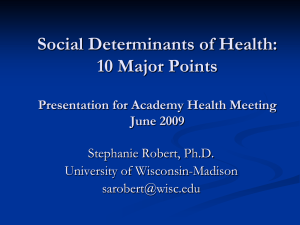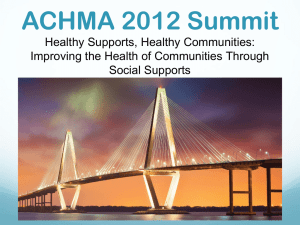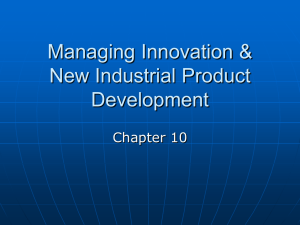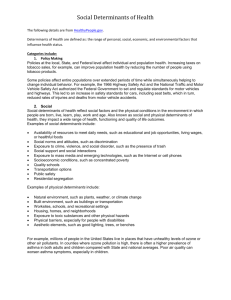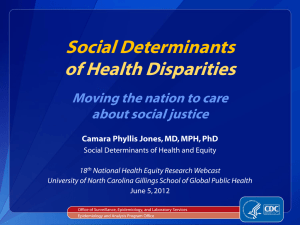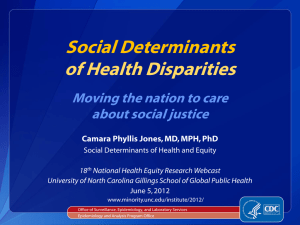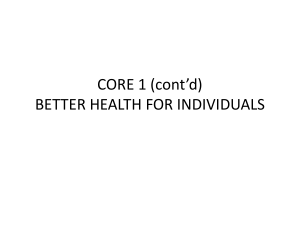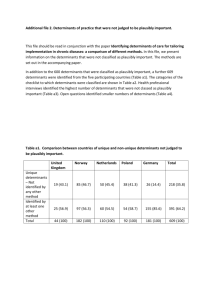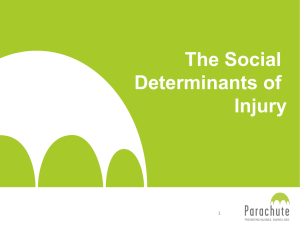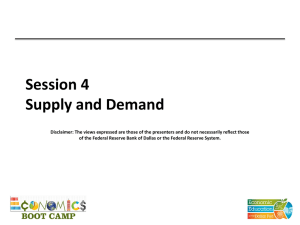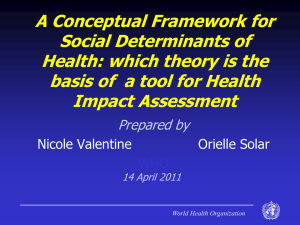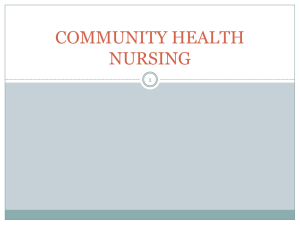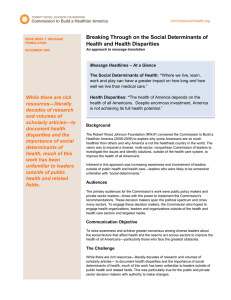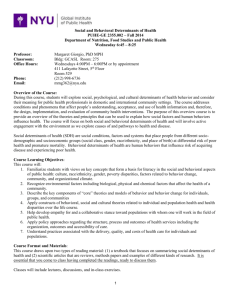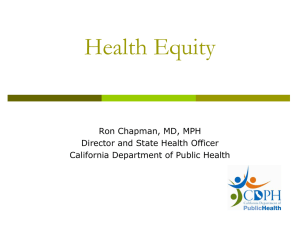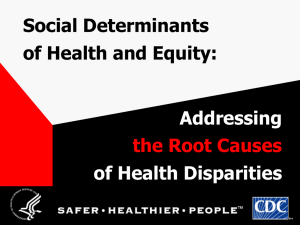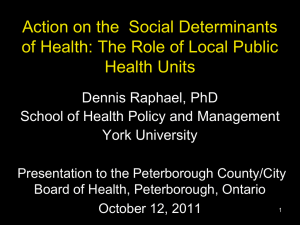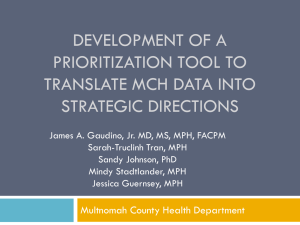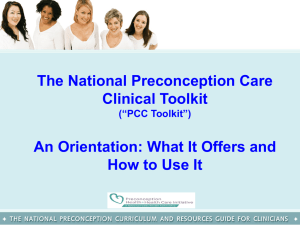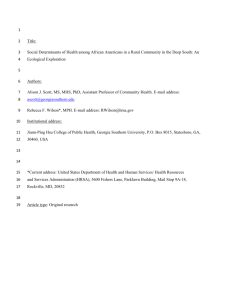Life-Course-Presentation-July-2014-2
advertisement
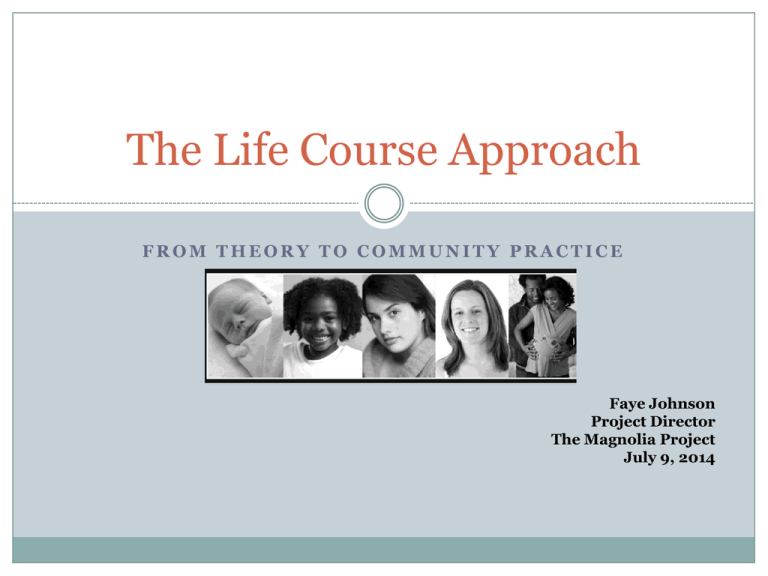
The Life Course Approach FROM THEORY TO COMMUNITY PRACTICE Faye Johnson Project Director The Magnolia Project July 9, 2014 Overview The Life Course in MCH Implications for practice From theory to practice Planning framework Prenatal Care & Case management Leadership Academy Life Course Perspective Back to the future! MCH historically focused on broader public health perspective Shift in focus over last decade Individual knowledge, skills Community, provider education Individual interventions Efforts to improve birth outcomes limited to nine months of pregnancy Improvements in maternal and infant survival Infant Mortality Infant mortality rate (2012): 8.4 deaths per 1,000 live births (2005 rate 11.6) IM driven by disparities 45% of births to Blacks & other nonwhites Blacks historically have poorer outcomes in Jax than other urban areas of state IM rate 2.5x higher than White rate Infant Mortality Duval County 25 White Total County 20 Target Area Black Linear (Target Area) 15 10 5 0 2005 2006 2007 2008 2009 2010 2011 2012 Beyond pregnancy Birth outcomes reflect life course of mother, not just pregnancy Proposed by Michael Lu & Neal Halfon (2003) Synthesis of two biomedical models Early programming Cumulative pathways Synthesis of Biomedical Models Early programming Exposures in early life could influence future reproductive potential Cumulative pathways Chronic accommodations to stress results in wear & tear contributing to declining health over time. Life Course Perspective Rather than focusing on risks, behaviors & services during pregnancy, CUMULATIVE effects of health, life events are examined. Health & socioeconomic status of one generation directly affects the health status --- and REPRODUCTIVE HEALTH CAPITAL – of the next one. Life Course Perspective Lu MC, Halfon N. Racial and ethnic disparities in birth outcomes: a life-course perspective. Matern Child Health J. 2003;7:13-30 Life Course Perspective Approach suggests a complex interplay of biological, behavioral, psychological and social protective factors contributes to health outcomes across the span of a person’s life. Factors impact racial, ethnic groups differently and may explain disparities despite equal access to care during pregnancy. Life-course model BROADENS the focus of MCH to include both health and social equity. Socioeconomic status, race and racism, health care, health status, stress, nutrition and weight, and a range of other behaviors impact birth outcomes. Factors impact racial, ethnic groups differently and may explain disparities despite equal access to care. Social Determinants of Health The social determinants of health are the conditions in which people are born, grow, live, work and age, including the health system. These circumstances are shaped by the distribution of money, power and resources at global, national and local levels, which are themselves influenced by policy choices. The influence of "social determinants" on health begins even before we are born. Study after study has outlined the ways in which a woman's health, diet and stress level during pregnancy affects her newborn's life chances: everything from neurological and emotional development to the likelihood of adult obesity. Proper nutrition, prenatal care, and exercise are important, but class, racism, loving relationships and place can also affect pregnant women. Socioeconomic Status. Lower socioeconomic status in childhood has been linked repeatedly with lower educational and income levels in adulthood, which in turn predict health status. Children in poor families are about seven times as likely to be in poor or fair health as children in the highest-income families. The social determinants of health are mostly responsible for health inequities - the unfair and avoidable differences in health status seen within and between countries. Examples of social determinants are: Lack of income, housing, poverty, unemployment, crime, poverty, racism etc…. Life Course Perspective Implications Life course framework in Maternal and Child Health has PROGRAMMATIC and POLICY implications. Changing practice Content of care is expanded Poverty Economic Education security Changing practice Services are organized and delivered in ways that build resiliency and social capital and reduce dependency Group care Self care Changing practice Requires inter-disciplinary, inter-agency collaboration to address complex needs From Theory to Community Practice • Planning Framework • Case Management • Reproductive Health • Preconception Care • Prenatal Care • Community Advocacy Planning Framework Planning Framework The Healthy Start program: individual case management and risk reduction services, not directly responsible for addressing social determinants. Plan strategies developed on two levels: What actions can be implemented through Healthy Start? What partnerships are needed between Healthy Start and other organizations working to address social equity? Looks at four phases: Infancy Childhood & Adolescence Preconception Pregnancy & Childbirth A Life Course Case Management Model The Magnolia Project, federal HS initiative in Jacksonville uses a preconception strategy to address racial disparities in birth outcomes. Two stage approach: Crisis stabilization, deal with immediate risks Longer term work to change trajectory (Life Plan) Case Management The individual Life Plan is participant- driven with established goals that address needs in three areas: Access to preventive health care Family & community support Reduction of poverty and social inequity Participants are enrolled in group activities that are specific to their Life Plan. Benefits Addresses the social determinants that influence poor birth outcomes. Promotes inter-and independence while building reproductive capital in the community. Contributes to improved self esteem of participants. Hard work! Staff vs. participant response. Life Course Service Delivery Model Individual services (mitigate, reduce risks) Group services (inter-dependence, self-reliance) Community capacity building Advocacy (social determinants) Benefit of Integrating The Life Course Perspective into Case Management The participants welcomed the change and were excited during the group activity. An opportunity to address the social determinants that influence poor birth outcomes Promoted inter-and independence while building reproductive capital in the community. Participants moved from relying on case managers to becoming leaders of group activities. The approach can contribute to improved self esteem among the women enrolled in case management. Life Course Plan The individual Life Course Plan is participantdriven with established goals and address needs in three areas: Access to preventive health care and related risk reduction services that improve a woman’s chances for healthy birth in the future. This includes basic reproductive health services, such as GYN care and family planning, as well as care for chronic diseases like diabetes, hypertension and obesity Life Course Plan Family and Community support including activities that provide at-risk women with the skills to develop healthy relationships and connectedness with communities through civic engagement and participation. Reduction of poverty and social inequities that assist participants in completing their education, gaining job skills, confronting discrimination and racism, and developing financial literacy. Community Advocacy The Make a Difference! Leadership Academy develops leadership skills and promotes civic engagement of case management participants and residents in high-risk neighborhoods. The Make a Difference Leadership Academy utilizes training material developed by the University of Arizona in 12 weekly sessions. The program is a research-based curriculum of current practices and theories designed to build capacity for grassroots leadership. The curriculum has been evaluated and demonstrated as effective for emerging leaders, individuals who have little or no leadership experience. The Make a Difference Leadership Academy changes the trajectory of a community through individuals being trained and assisted in the development of a Community Action Plan to move a community to action. The Life Course Perspective Change in approach = positive response from participants, MOST staff Model has impacted the way we do business Use of life course framework in update of Healthy Start Service Delivery Plan New collaborations in economic self-sufficiency, community development How to incorporate in the State HS care coordination system?? Developed the Make a Difference Leadership Academy Thank you! fjohnson@nefhsc.org
